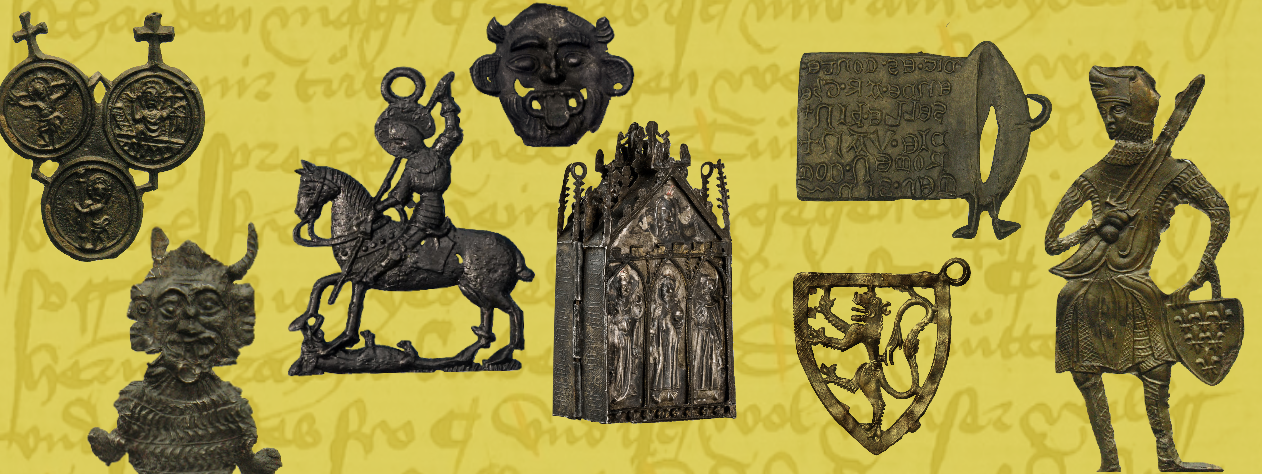Sexual Badges, fertility, and… eggplants?
The woman flanked by trees cocks her head. Her indeterminate gaze seeks neither what’s in front of her nor the viewer. Both her hands are outstretched, connecting the two halves of the scene and guiding the viewer’s eyes to the phallus below. Is it being harvested or planted? Only the woman knows…
Pewter badge, woman with shovel touching buried and sleeping phalluses, pin, origin unknown, 1300-1349, found in Ypres, Belgium, 25 x 30 mm. Ypres, Belgium, Yper Museum, inv. 002954 (Kunera 06915). Photographer: Els Deroo. Photograph courtesy of Yper Museum.
The first time I saw such a scene depicted on such a small metal object, I wasn’t certain what to make of it. Learning later that this scene is one of many medieval sexual badges surviving from the Middle Ages does not make ascertaining less complex. Medieval badge scholars also ponder this mystery. Unlike other medieval badges of identifiable saints, pilgrimage icons, coat of arms, etc., all of which have a discernable purpose in their medieval context, the ‘why’ behind sexual badges remains unknown.
Sexual imagery on medieval badges is incredibly varied. There are badges, like the one above, featuring phalluses being shovelled. There are others with phalluses on trees or in baskets and others featuring images of walking phalluses with bells or phalluses roasting on spits. Vulvas are dressed as pilgrims: some vulvas are on stilts, others are paraded around. To ask the craftsmen and the wearers of one badge, what the purpose of this badge is might not solve the mystery of another badge. Although the ‘why’ is a mystery, it is not without hints.
Any medieval viewer would have known the medieval phallic semiotic system was not limited to badges. Phallus trees were common across mediums in the medieval times: on a fountain mural in Massa Marittima, Italy, in wood carvings, and in literature. There is a record of phallus trees frequenting the carnival in Nördlingen, Germany in 1510. In some of these images, phalluses are linked to the natural world and are represented as birds or fruit.
In the badge above, there’s an obvious association with nature. Ann Marie Rasmussen draws attention to the trees surrounding the scene and that it is all happening outdoors, in a field or maybe a garden. She says this scene alludes to “a complex visual metaphor in which the penis functions like a seed because, in the area of generation and reproduction, it produces seed.”
Placing this badge in the larger context of other badges with the same visual metaphor tells an interesting story. In the Kunera database, there are three almost identical badges (Kunera 05341, Kunera 06915, Kunera 06916). In all three, we can see trees flanking a person with a shovel, and a phallus in the foreground. The captions on the Kunera database all refer to the phallus as not yet awakened. There is another badge, Kunera 06917, that conveys a similar theme with a different image. In this badge, there is a man holding a shovel on one side and a woman on the other, caressing the top of a phallus that looks like it is beginning to sprout. Uniquely in this sample of four badges, Kunera 06917 has an inscription, VEDELAPRI, which scholars have not yet deciphered.
Looking at these badges together begs a return to the question I initially asked: is the phallus being planted or harvested? These badges suggest, however, that there is a continuity between seed, plant, and fruit. It’s peculiar to witness this continuity when the seed is perceived as a changing entity; something whose fate is grow into a different form of itself. The visual system those in the medieval times lived within invites us to see time manifest in the phallus as the unchanging entity that is at once seed, plant, and fruit. Understanding this mystery requires an acceptance of the blurring of our own conceptions.
The idea of phalluses, plants, and fertility is not unknown to us in modern times. Think, for instance, of the eggplant emoji, used as a placeholder for a phallus. There is more than one reason why the plant has gained its natural association (need I explain?). The same holds true for phallus trees or phallus plants.
Discovering how humans have made and continue to make meaning about and through sexual genitalia is an intriguing mystery for all of us. It’s a visual system we’re socialized into knowing, a code that makes sense through the world we live in. Surely we can look at these badges and cock our own heads wondering what’s happening, but we need to remember that the gaze looking back at us would wonder the same.
Written by Hannah Gardiner.
Works Cited
Mattelaer, Johan J. “The Phallus Tree: A Medieval and Renaissance Phenomenon,” in The Journal of Sexual Medicine 7, no. 2 (2010): pp. 846–51.
Rasmussen, Ann Marie. Medieval Badges: Their Wearers and Their Worlds. (Philadelphia: University of Pennsylvania Press, forthcoming).
Rasmussen, Ann Marie. “Moving Beyond Sexuality in Medieval Sexual Badges,” in From Beasts to Souls, ed. E. Jane Burns and Peggy McCracken (Notre Dame: University of Notre Dame Press, 2013), pp. 221–47.
Rasmussen, Ann Marie. Wandering Genitalia: Sexuality & the Body in German Culture between the Late Middle Ages & Early Modernity (London: King’s College London, 2009).

